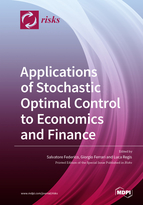Applications of Stochastic Optimal Control to Economics and Finance
A special issue of Risks (ISSN 2227-9091).
Deadline for manuscript submissions: closed (31 January 2019) | Viewed by 24448
Special Issue Editors
Interests: stochastic optimal control theory in finite and infinite dimension; problems with delay; stochastic partial differential equations; viscosity solutions of PDEs; singular stochastic control and optimal stopping
Interests: singular stochastic control; optimal stopping; free-boundary problems; impulse control; stochastic games; real options; mathematical finance; mathematical economics; insurance mathematics
Interests: actuarial mathematics; insurance; risk management; longevity risk; asset-liability management; financial mathematics; corporate finance
Special Issues, Collections and Topics in MDPI journals
Special Issue Information
Dear Colleagues,
Many problems in economics, finance, and actuarial science naturally lead to optimal agents’ dynamic choices in stochastic environments. Examples include optimal individual consumption and retirement choices, optimal management of portfolios and of risk, hedging, optimal timing issues in pricing American options or in investment decisions.
Stochastic control theory provides the methods and results to tackle all such problems, and this Special Issue aims at collecting high quality papers on the theory and application of stochastic optimal control in economics and finance, and its associated computational methods.
Prof. Salvatore FedericoProf. Giorgio Ferrari
Dr. Luca Regis
Guest Editors
Manuscript Submission Information
Manuscripts should be submitted online at www.mdpi.com by registering and logging in to this website. Once you are registered, click here to go to the submission form. Manuscripts can be submitted until the deadline. All submissions that pass pre-check are peer-reviewed. Accepted papers will be published continuously in the journal (as soon as accepted) and will be listed together on the special issue website. Research articles, review articles as well as short communications are invited. For planned papers, a title and short abstract (about 100 words) can be sent to the Editorial Office for announcement on this website.
Submitted manuscripts should not have been published previously, nor be under consideration for publication elsewhere (except conference proceedings papers). All manuscripts are thoroughly refereed through a single-blind peer-review process. A guide for authors and other relevant information for submission of manuscripts is available on the Instructions for Authors page. Risks is an international peer-reviewed open access monthly journal published by MDPI.
Please visit the Instructions for Authors page before submitting a manuscript. The Article Processing Charge (APC) for publication in this open access journal is 1800 CHF (Swiss Francs). Submitted papers should be well formatted and use good English. Authors may use MDPI's English editing service prior to publication or during author revisions.
Keywords
- Individual’s optimal investment/consumption policies;
- Optimal annuitization;
- Real options;
- Optimal timing issues in financial and economic problems;
- Stochastic games;
- Pricing and hedging of financial derivatives;
- Systemic risk;
- Credit risk;
- Pension funds management;
- Theoretical and computational methods in stochastic processes.






